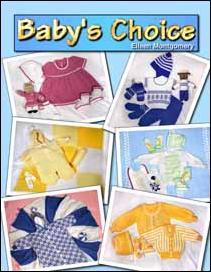|
There are a number of considerations when knitting for little ones. If you want baby to be allowed to wear your creation, be sure that it is knit in a machine wash & dryable acrylic or cotton. To keep baby comfortable, avoid buttons on the backs of garments and place zippers so that they do not come all the way up to pinch baby’s chin(s). Babies will chew on anything so resist the temptation to use cute buttons that have sharp points; stay with simple round shank buttons. Use thin elastic or dental floss to sew buttons on, beads should be knit in, embellishments very firmly attached, and paints should be non-toxic.
When placing a pattern on a baby’s garment, be sure to continue on the back as that is what people see the most as baby snuggles up to its parents. Consider placing a pattern above the cuffs, because babies will amuse themselves for long periods of time trying to pick the pattern off.
Take the time to go to the baby department to check out the current colours and styles. Babies and their mothers prefer bright primary colours, not the pastels of old. For more wearings, be sure most of the sweaters you knit will go with denims and Nikes.
One of the biggest problems is deciding which size to knit. The best way is to measure the baby; but remember, if you do not finish the sweater this week, it may not fit. You may be told that the baby is currently wearing a certain size garment, so you could go to the store and discreetly measure that size and the next.
If you are knitting a gift, I would suggest that you knit garments to fit at least 12 months and up. Babies start life in such a variety of sizes and most people choose tiny sizes, so larger garments will more likely be appreciated. When in doubt, knit large because babies will always grow into it. Babies grow rapidly, but more in length than in width. So if you want to make a garment that baby can wear for a longer time, add to the length of the body and sleeves. Consider knitting the cuffs long so that they can be worn turned back until the extra length is needed. If you add too much ease to the width to allow for growth, the garment will look too big and sloppy.
Remember that babies are not proportioned the same as adults. Their waists, wrists, chins and heads are larger in comparison. This is where the challenge of knitting for babies comes in. A baby’s head will measure approximately 46 cm/18” at 6 months and will grow steadily to reach full adult size of 56 cm/22” by 10 years of age. We need to knit the neck of a garment to fit the baby properly when worn but we have to allow the neck to be pulled on and off without distressing the baby. Consider leaving one or two shoulders open and use buttons to close after the sweater is on. Other options include boatnecks, back slits or V-necks. If you can pull the baby’s sweater over your head and remove it without losing an ear, you can be sure that it will fit the baby.
Babies have no shape except perhaps protruding tummies. To allow the sweater to cover the tummy without being too tight and to prevent riding up, use a tunic-style hem on the bottom or knit the waistband ribbing at one number looser than usual. Note there is no need to shape the shoulders on a baby garment as they are squarer than adults. The back neck should be shaped because of baby’s thick neck. To allow for baby’s chubby chins, knit ribbed neckbands slightly looser than usual and work as single bands to avoid unnecessary bulk. Be sure that any casting off in the neck area is done loosely.
Knitting for Babies using DesignaKnit:
DesignaKnit gives seven Standard sizes for babies. After comparing these measurements with several standard sizing charts, I label the sizes as 3, 6, 12, 18 months, Toddler 2, 3 and 4. Consider these ages as suggestions only as babies’ ages and sizes vary far too much for standardization.
I prefer to make some changes to the default measurements on the Styling screen. On the body and sleeve, the ribbing is changed to 4.3 cm/1.7”. I want ribbed cuffs which will stretch enough to put my fingers through when dressing baby so the measurements that I use for the cuffs are for sizes 1-2, 11.5 cm/4.5”; sizes 3-4, 14 cm/5.5”; sizes 5-7, 16.5 cm/6.5”. On all sizes, I use 12 cm/.7” for the back neck depth and 2 cm/.8” for the neckband.
Because I prefer my neck shaping deeper than the defaults, I make the following adjustments to the neck styling:
|
|



